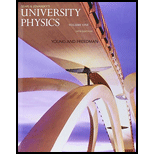
The accompanying figure shows a wire coil being squeezed in a uniform magnetic field. (a) While the coil is being squeezed, is the induced emf in the coil (i) clockwise, (ii) counterclockwise, or (iii) zero? (b) Once the coil has reached its final squeezed shape, is the induced emf in the coil (i) clockwise, (ii) counterclockwise, or (iii) zero?
Learn your wayIncludes step-by-step video

Chapter 29 Solutions
University Physics with Modern Physics, Volume 1 (Chs. 1-20) and Mastering Physics with Pearson eText & ValuePack Access Card (14th Edition)
Additional Science Textbook Solutions
Chemistry: An Introduction to General, Organic, and Biological Chemistry (13th Edition)
Genetic Analysis: An Integrated Approach (3rd Edition)
Organic Chemistry (8th Edition)
Physics for Scientists and Engineers: A Strategic Approach, Vol. 1 (Chs 1-21) (4th Edition)
Anatomy & Physiology (6th Edition)
Human Anatomy & Physiology (2nd Edition)
- Which of the following laws is true regarding tensile strength? • tensile strength T ①Fbreak = Wtfest Piece thickness rate (mm) ②T = test piece width rabe (mm) Fbreak break watarrow_forwardThe position of a squirrel running in a park is given by = [(0.280 m/s)t + (0.0360 m/s²)t²] + (0.0190 m/s³)ť³ĵj. What is v₂(t), the x-component of the velocity of the squirrel, as a function of time?arrow_forwardNo chatgpt pls will upvotearrow_forward
- You hold a spherical salad bowl 85 cm in front of your face with the bottom of the bowl facing you. The salad bowl is made of polished metal with a 40 cm radius of curvature. Where is the image of your 2.0 cm tall nose located? What is image's size, orientation, and nature. I keep getting the answer -26.2, but it keeps saying it is wrong. I just want to know what i'm doing wrong.arrow_forwardA converging lens with a focal length of 6.70 cm forms an image of a 4.60 mm tall real object that is to the left of the lens. The image is 1.50 cm tall and erect. Where are the object and image located? Is the image real or virtual? Please show all stepsarrow_forwardNo chatgpt pls will upvotearrow_forward
- need help part earrow_forwardCritical damping is the case where the mass never actually crosses over equilibrium position, but reaches equilibrium as fast as possible. Experiment with changing c to find the critical damping constant. Use the same initial conditions as in the last problem. Zoom in a bit to make sure you don't allow any oscillations to take place - even small ones.arrow_forwardNASA's KC-135 Reduced Gravity Research aircraft, affectionately known as the "Vomit Comet," is used in training astronauts and testing equipment for microgravity environments. During a typical mission, the aircraft makes approximately 30 to 40 parabolic arcs. During each arc, the aircraft and objects inside it are in free-fall, and passengers float freely in apparent "weightlessness." The figure below shows the altitude of the aircraft during a typical mission. It climbs from 24,000 ft to 30,850 ft, where it begins a parabolic arc with a velocity of 155 m/s at 45.0° nose-high and exits with velocity 155 m/s at 45.0° nose-low. 31 000 45° nose high 45° nose low 24 000 Zero g 65 Maneuver time (s) (a) What is the aircraft's speed (in m/s) at the top of the parabolic arc? 110.0 m/s (b) What is the aircraft's altitude (in ft) at the top of the parabolic arc? 2.04e+04 What is the initial height at the start of the parabolic arc? What is the initial velocity at this point? What is the final…arrow_forward
 Physics for Scientists and Engineers: Foundations...PhysicsISBN:9781133939146Author:Katz, Debora M.Publisher:Cengage Learning
Physics for Scientists and Engineers: Foundations...PhysicsISBN:9781133939146Author:Katz, Debora M.Publisher:Cengage Learning Principles of Physics: A Calculus-Based TextPhysicsISBN:9781133104261Author:Raymond A. Serway, John W. JewettPublisher:Cengage Learning
Principles of Physics: A Calculus-Based TextPhysicsISBN:9781133104261Author:Raymond A. Serway, John W. JewettPublisher:Cengage Learning Physics for Scientists and Engineers, Technology ...PhysicsISBN:9781305116399Author:Raymond A. Serway, John W. JewettPublisher:Cengage Learning
Physics for Scientists and Engineers, Technology ...PhysicsISBN:9781305116399Author:Raymond A. Serway, John W. JewettPublisher:Cengage Learning
 Physics for Scientists and Engineers with Modern ...PhysicsISBN:9781337553292Author:Raymond A. Serway, John W. JewettPublisher:Cengage Learning
Physics for Scientists and Engineers with Modern ...PhysicsISBN:9781337553292Author:Raymond A. Serway, John W. JewettPublisher:Cengage Learning Physics for Scientists and EngineersPhysicsISBN:9781337553278Author:Raymond A. Serway, John W. JewettPublisher:Cengage Learning
Physics for Scientists and EngineersPhysicsISBN:9781337553278Author:Raymond A. Serway, John W. JewettPublisher:Cengage Learning





